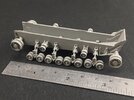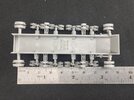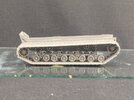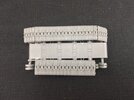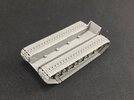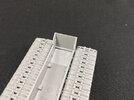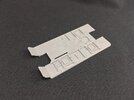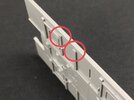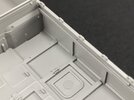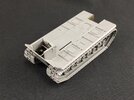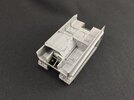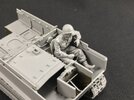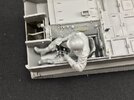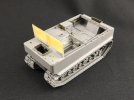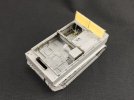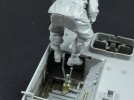- Joined
- Apr 28, 2018
- Messages
- 10,791
- Points
- 113
- First Name
- Jakko
As mentioned elsewhere, I now have not one or even two, but altogether five M29 and M29C Weasel kits … And as mentioned there, part of the blame for that lies on a YouTube video of a review of the Takom kit which raised questions — questions about the review, that is.
When someone complains that a model is hard to build, it usually leaves me thinking that I would like to see for myself how bad it really is. This time, I submitted to that and purchased Takom’s M29. I got it in the mail yesterday, and extraordinarily, I already started it last night The LCA is on hold for the moment.
The LCA is on hold for the moment.
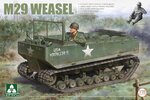
One small mistake with the box-top painting is that the vehicle is in motion here (see the mud coming off the track) but you can’t drive a Weasel with one arm out the window … It has two steering levers, so the driver would need to push both of those forward to get the vehicle to move. But it looks good
Here’s what you get in the box:
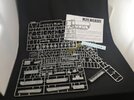
The instructions are on Scalemates, for those who want to follow along. I decided to follow the YouTube video and build the model according to the order of the instructions, starting with the first step and proceeding towards the last one, instead of doing what I usually do and decide for myself on the order in which I add bits to to the model. This mainly because it looks like that’s what the chap in the video did as well, and I want to discover if the problems he had with the kit were caused by Takom, or by himself.
Step 1 is the underside of the hull with the suspension and the supports for the return rollers and idler wheels. After building most of that step, you end up with this:
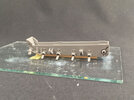
That looks simple, but it’s quite a lot of work: it took me over three quarters of an hour to separate, clean up and fit the parts. This, by the way, is the left-hand side: the bit sticking up on the left is the front of the vehicle. What you can see here are 19 parts: hull plus 18 for the suspension etc. on this side — so another 18 on the other side. Each of the return roller supports is three parts, and for the rear one you need to take care that you don’t fit its axle (A16) upside down, because you can. The arm for the idler wheel is four parts (arm, leaf spring, saddle for the spring, and support on the hull that the spring sits against), while along the lower edge there are four separate leaf springs (A20) and the covers over them (A22).
Those springs are the biggest problem here: you have to take care not to break off the end when you clean them, and they fit very loosely into the hull. The spring is attached to the sprue near its outboard end, but if you try to clean up the attachment point by slicing it off lengthwise, from the inboard side out, you will break off the end of the spring. Better to lay it flat on its side on your work surface and cut the attachment point off from the side.
Once cleaned, the springs have a lot of play in the hull, both up and down, and forward and back. Take care to get them at right angles to the hull and not up against the covers A22. On the real Weasel, those serve as bump stops, so if you glue the springs up against them, the suspension is compressed all the way. This is why I’ve put the hull onto a few bits of balsa on a pane of glass: so that I can press all suspension arms against the glass and get them at the same height. (My thoughts are that the man from the video had half a link too many in his tracks because he did glue the springs against the covers, but I can’t see whether or not he did in the video. It would neatly explain his problems with the length of the track, though.)
In step 1 you also get to fit the upper suspension arms, in the rectangular slots above the springs, but I left them off for now because otherwise it will be very difficult to line them up correctly with the bogies that will only be built and fitted in step 2, and it was getting too late last night for that. Why? Well, four bogies with two axles each, and each axle has two wheels on the inside and two on the outside. With three other parts per bogie plus the upper suspension arm, that makes for 96 parts to clean up and fit. I didn’t feel like doing that anymore late last night
When someone complains that a model is hard to build, it usually leaves me thinking that I would like to see for myself how bad it really is. This time, I submitted to that and purchased Takom’s M29. I got it in the mail yesterday, and extraordinarily, I already started it last night
 The LCA is on hold for the moment.
The LCA is on hold for the moment.
One small mistake with the box-top painting is that the vehicle is in motion here (see the mud coming off the track) but you can’t drive a Weasel with one arm out the window … It has two steering levers, so the driver would need to push both of those forward to get the vehicle to move. But it looks good

Here’s what you get in the box:

The instructions are on Scalemates, for those who want to follow along. I decided to follow the YouTube video and build the model according to the order of the instructions, starting with the first step and proceeding towards the last one, instead of doing what I usually do and decide for myself on the order in which I add bits to to the model. This mainly because it looks like that’s what the chap in the video did as well, and I want to discover if the problems he had with the kit were caused by Takom, or by himself.
Step 1 is the underside of the hull with the suspension and the supports for the return rollers and idler wheels. After building most of that step, you end up with this:

That looks simple, but it’s quite a lot of work: it took me over three quarters of an hour to separate, clean up and fit the parts. This, by the way, is the left-hand side: the bit sticking up on the left is the front of the vehicle. What you can see here are 19 parts: hull plus 18 for the suspension etc. on this side — so another 18 on the other side. Each of the return roller supports is three parts, and for the rear one you need to take care that you don’t fit its axle (A16) upside down, because you can. The arm for the idler wheel is four parts (arm, leaf spring, saddle for the spring, and support on the hull that the spring sits against), while along the lower edge there are four separate leaf springs (A20) and the covers over them (A22).
Those springs are the biggest problem here: you have to take care not to break off the end when you clean them, and they fit very loosely into the hull. The spring is attached to the sprue near its outboard end, but if you try to clean up the attachment point by slicing it off lengthwise, from the inboard side out, you will break off the end of the spring. Better to lay it flat on its side on your work surface and cut the attachment point off from the side.
Once cleaned, the springs have a lot of play in the hull, both up and down, and forward and back. Take care to get them at right angles to the hull and not up against the covers A22. On the real Weasel, those serve as bump stops, so if you glue the springs up against them, the suspension is compressed all the way. This is why I’ve put the hull onto a few bits of balsa on a pane of glass: so that I can press all suspension arms against the glass and get them at the same height. (My thoughts are that the man from the video had half a link too many in his tracks because he did glue the springs against the covers, but I can’t see whether or not he did in the video. It would neatly explain his problems with the length of the track, though.)
In step 1 you also get to fit the upper suspension arms, in the rectangular slots above the springs, but I left them off for now because otherwise it will be very difficult to line them up correctly with the bogies that will only be built and fitted in step 2, and it was getting too late last night for that. Why? Well, four bogies with two axles each, and each axle has two wheels on the inside and two on the outside. With three other parts per bogie plus the upper suspension arm, that makes for 96 parts to clean up and fit. I didn’t feel like doing that anymore late last night

Last edited:





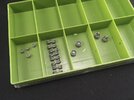
 Takom’s idea is that the bogies click onto the ends of the leaf springs: they have little dimples on both sides, and there are two corresponding pips inside the square opening that runs through A19. But if you try to push those pips into the dimples, you break everything because that requires a lot more force than these fragile parts can take
Takom’s idea is that the bogies click onto the ends of the leaf springs: they have little dimples on both sides, and there are two corresponding pips inside the square opening that runs through A19. But if you try to push those pips into the dimples, you break everything because that requires a lot more force than these fragile parts can take 